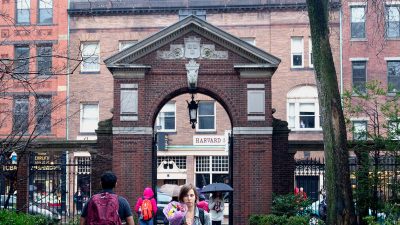The First Circuit U.S. Court of Appeals sided with Harvard University in a yearslong discrimination case Thursday, ruling that the University does not intentionally discriminate against Asian-American applicants.

Harvard’s “limited” consideration of race in its admissions process meets legal standards and does not violate Title VI of the 1964 Civil Rights Act, which prohibits institutions that receive federal funding from discriminating on the basis of race, the court ruled.
“Harvard has an ‘ongoing obligation to engage in constant deliberation and continued reflection regarding its admissions policies,’” Circuit Judge Sandra Lynch wrote in the decision. “The issue before us is whether Harvard’s limited use of race in its admissions process in order to achieve diversity in the period in question is consistent with the requirements of the Supreme Court precedent. There was no error.”
Students for Fair Admissions, the organization behind the suit, plans to appeal the decision to the Supreme Court, President Edward Blum wrote in an email statement.
“While we are disappointed with the opinion of the First Circuit Court of Appeals, our hope is not lost,” Blum wrote. “We will ask the justices to end these unfair and unconstitutional race-based admissions policies at Harvard and all colleges and universities.”
Harvard spokesperson Rachael Dane wrote in an email that the decision affirms the University’s ability to pursue a diverse campus community that “encourages mutual respect and understanding.”
In the case, Harvard argued that diversity is fundamentally important in students’ and faculty members’ pursuit of new knowledge.
The verdict is unsurprising, as Harvard’s use of race in its decision-making does not deviate from previous case law, said Kimberly West-Faulcon, the James P. Bradley chair in Constitutional Law at Loyola Law School.
Harvard applies six types of rankings to students during its admissions process — which range from “academic” to “personal” ratings and culminating in an “overall” rating from 1–6, according to the ruling. While race is not central to any of these scores, factors such as unique creativity, athletic ability or race can “tip” an applicant into the admitted class.
Colleges can legally consider race in admissions processes so long as they avoid quotas and deliberate race-balancing, West-Faulcon said, and can demonstrate a “compelling purpose” for doing so.
The Circuit Court ruled that Harvard’s practices were “narrowly tailored” enough to survive strict scrutiny and that they could not be replaced by workable, race-neutral alternatives.
West-Faulcon added that the Harvard case is just one part of an ongoing legal battle against affirmative action policies, on the basis that they effectively discriminate against applicants who are traditionally over-represented in higher education.
That battle began in the 1970s, she said, with the Supreme Court case Regents of the University of California v. Bakke, in which Allan Bakke, a white man, alleged that University of California Davis School of Medicine violated his 14th Amendment rights by denying him admission due to a minority-admit quota.
Blum has a history of involvement in anti-affirmative-action cases.
In addition to being president of SFFA, he is the also the director of the Project on Fair Representation, which filed two lawsuits against the University of Texas at Austin alleging racial discrimination against Abigail Fisher, a white applicant.
“He’s the moving force behind all these cases,” said Theodore Shaw, director of the Center for Civil Rights at the University of North Carolina School of Law. “He is basically someone who’s opposed to any efforts to pursue, one way or another, racial equity or equality, because he says all of that constitues so-called reverse discrimination.”
Blum did not respond to multiple requests for further comment.
West-Faulcon said the nature of the Harvard case — alleging discrimination against Asian-American students, rather than white applicants — is designed to be misleading to the public.
Shaw added that while both Black and Asian Americans have a history of suffering discrimination in the United States, Black students are disproportionately affected by the legacy of that discrimination, especially in public schools.
“And Ed Blum comes in and, I think, exploits that,” Shaw said.
Title VI, the basis of SFFA’s case against Harvard, was established to combat deliberate discrimination against Black children in the public schools following the 1954 Brown v. Board of Education decision, West-Faulcon said.
“It is really perverse that this is Title VI, something that Congress put on the books to vindicate the constitutional events that create statutory rights,” she said, “for Black children who would not be admitted to a public school that just had a policy, ‘We don’t want Black kids to come to the school.”
The Harvard case is the first discrimination lawsuit challenging affirmative action to be filed against a private university, Shaw said.
If accepted by the Supreme Court, the case could threaten the broader legal standing of affirmative action, West-Faulcon said, especially given the Court’s new conservative majority created by Amy Coney Barrett’s confirmation in late October.
West-Faulcon added that the case will likely not reach the Court this term, but that once it does, there would be little the public can do to sway the Court’s decision-making.
Both West-Faulcon and Shaw said anti-affirmative action lawsuits like this one attempt to create a false equivalency between the country’s legacy of discrimination and efforts to rectify it, by comparing race consciousness to outright racism.
“It’s impossible to address racial inequality that’s the result of passing or continuing discrimination without being conscious of it,” Shaw said. “That would be like saying that we’re going to cure a disease, but we’re not allowed to make a diagnosis, because the diagnosis itself becomes the disease in their minds. That’s not rational, it doesn’t make sense.”






















































































































